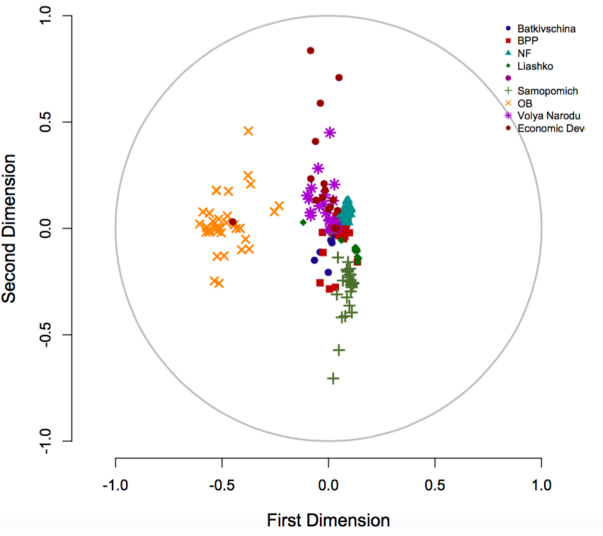An irregular vote is not a proof of anything but may be indicative of political pressure or trading of political promises for votes, some unusual deals between the member of the parliament and parties interested in passing or blocking the law, corruption, or a strong independent ideological position on this specific law.
This article lists
- ten members of the parliament with most irregular pattern of votes, and
- ten rollcalls (votes) with the most irregular pattern of votes.
Here are the names of the members of the parliament, where the first position corresponds to the most irregular pattern and the last one to the least irregular pattern of votes.
- Rudyk Serhiy Yaroslavovych
- Musiy Oleh Stepanovych
- Pynzenyk Viktor Mykhaylovych
- Rybak Ivan Petrovych
- Bezbakh Yakiv Yakovych
- Kaplin Serhiy Mykolayovych
- Mel’nychuk Serhiy Petrovych
- Baloha Viktor Ivanovych
- Taruta Serhiy Oleksiyovych
- Novak Nataliya Vasylivna
Here is the list of the rollcalls
- Проект Закону про внесення змін до деяких законів України щодо регулювання виробництва та обігу пива. (4 votes)
- Проект Закону про внесення зміни до статті 10 Закону України “Про особливий порядок місцевого самоврядування в окремих районах Донецької та Луганської областей”
- Проект Постанови про попереднє схвалення законопроекту про внесення змін до Конституції України щодо децентралізації влади
- Проект Постанови про визначення окремих районів, міст, селищ і сіл Донецької та Луганської областей, в яких запроваджується особливий порядок місцевого самоврядування
- Проект Закону про внесення змін до Закону України “Про порядок здійснення розрахунків в іноземній валюті” щодо валютного регулювання та валютного контролю
- Проект Закону про енергетичну ефективність будівель
- Проект Закону про внесення змін до деяких законів України щодо приведення їх у відповідність до положень Закону України “Про ринок природного газу” (щодо особливостей провадження господарської діяльності на ринку природного газу)
A vote is irregular if a member of parliament votes differently from his predicted vote obtained from the votes on the other laws. An irregular vote is not a proof of anything but may be indicative of political pressure or trading of political promises for votes, some unusual deals between the member of the parliament and parties interested in passing or blocking the law, corruption, or a strong independent ideological position on this specific law.
The votes were classified using the optimal classification algorithm by Keith Poole, described in Keith Poole. 2000. ‘Non-parametric Unfolding of Binary Choice Data.’ Political Analysis, 8(3):211- 237
The software is available at https://cran.r-project.org/web/packages/oc/index.html
The data is all the votes from the VIII-th Rada, Sessions 1 and 2.
The algorithm tries to position the members of the parliament in a two dimensional space and find a cutting line for each law such that this line splits the members of the parliament into the groups who votes yes and no (absent, abstain, etc votes are ignored). The algorithm minimizes the number of errors in classification. Specifically, it minimizes the sum of distances between the position of the member of the parliament and the cutting line corresponding to the law on which the member of the parliament is misclassified. A vote is irregular if the algorithm misclassifies it (e.g, the algorithm puts a member of the parliament in the group with yes votes, but the member of the parliament votes no).
Figure one depicts the classification of the parliament according to the algorithm. The input command in the algorithm was as follows
class<-oc(RC, dims=2, minvotes=20, lop=0.025, polarity=c(1,2), verbose=FALSE)
This implies that the algorithm ignores all rollcalls (laws) for which there were less than 20 yes or no votes were ignored (for instance, if everyone abstained or was not present) and for which there was less than 2,5% different votes (for example, if 99% voted yes and 1% votes no).
The ranking of the irregular votes for the members of the parliament and the laws are obtained by summing the number of classification errors. The first 10 MPs and the first 10 laws with the largest number of classification errors are listed above.
This ranking, which is based on the classification errors, is not a proof of anything. It is rather an indication of some irregularity in behavior suggesting that one might want to take a closer look at some members of parliament and at some laws to understand the reasons for irregularity in votes.
Attention
The author doesn`t work for, consult to, own shares in or receive funding from any company or organization that would benefit from this article, and have no relevant affiliations




